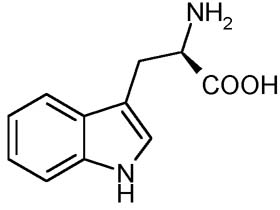
Tryptophan (see figure at left) is one of the 20 naturally occurring amino acids that make up the proteins in our body. Since humans are unable to synthesize tryptophan from basic building blocks, we must consume it in our diet. There are ten essential amino acids that we must consume in adequate amounts: Arginine (only for young), histidine, isoleucine, leucine, lysine, methionine, phenylalanine, threonine, tryptophan, and valine.
 So where does the link between tryptophan and sleep come from? Tryptophan is a precursor in the synthesis of two important signaling molecules, serotonin and melatonin (see pathway at right). Serotonin is a neurotransmitter that has multiple effects in both the central and peripheral nervous system. In the CNS, it has been shown to regulate sleep and mood. The effects of the hormone melatonin are opposite those of serotonin: What one inhibits, the other will activate.
So where does the link between tryptophan and sleep come from? Tryptophan is a precursor in the synthesis of two important signaling molecules, serotonin and melatonin (see pathway at right). Serotonin is a neurotransmitter that has multiple effects in both the central and peripheral nervous system. In the CNS, it has been shown to regulate sleep and mood. The effects of the hormone melatonin are opposite those of serotonin: What one inhibits, the other will activate.So is there enough tryptophan in turkey to account for the sleepiness we feel after Thanksgiving dinner? According to this chart, turkey falls somewhere in the middle range as far as grams of tryptophan per 100 grams of food, with 0.24 g tryptophan per 100 grams of turkey. Compare this with egg whites, which have 1.00 g tryptophan per 100 g (dry), or Parmesan cheese, which has 0.56 g tryptophan per 100 g. Additionally, tryptophan is converted to melatonin in the intestine, where it functions to regulate digestion (peristalsis). Very little of this intestinal melatonin will enter the blood stream to get to the brain and make us feel sleepy, although there is evidence that if there is an excess in the intestine, some melatonin will leak into the blood stream. There is also a link between extra tryptophan in the diet and melatonin in the bloodstream. This increase in melatonin level has been shown to cause a phase shift the body's circadian rhythm, the normal cycle of resfulness and alertness that is common in all living things. This phase shift may make our bodies think it is later than it actually is, which contributes to a feeling of sleepieness. Interestingly, this phase shift may also contribute to feelings of wakefulness later in the night.
However, these studies were done in rats and chickens with pure tryptophan introduced directly to the stomach. The problem with this is that you do not eat a big plate full of tryptophan on Thanksgiving, or even a big plate of only turkey. You eat a big plate of turkey, stuffing, mashed potatoes, gravy, dinner rolls, pumpkin pie, etc. Adding all these extra nutrients will affect the absorption of melatonin into the bloodstream. Another problem is that tryptophan works best to stimulate sleep on empty stomach - something that is very rare after Thanksgiving dinner.
So what causes the sleepies? There are a few other suspects associated with Thanksgiving dinner. Carbohydrates, such as the starch found in potatoes, stuffing and bread may indirectly lead to an increase in tryptophan in the blood. Fats tend to slow down digestion of all parts of the meal, which makes digestion take longer and lead to longer periods of fullness. If there is alcohol served at dinner, it will function as a general depressant of the central nervous system.
In my opinion, the most likely culprit is simply the size of the meal. The typical Thanksgiving dinner contains more than 4000 calories. The USDA recommends about 2500 calories per day, so some people are basically eating two days worth of food in one sitting. When you are digesting, the body diverts blood flow away from the extremities and brain to the digestive system. This is why it often feels colder outside after eating - less blood in the extremities to keep them warm. Less blood to the brain means less oxygen, which may make you feel tired. There are a few calorie calculators out there for you to try to regulate your food intake. They are not perfect, but they will give you a rough idea of how much you are eating.
So what should you do? I am going to eat a small breakfast, probably not much lunch and try to go light on the appetizers. Then I can eat as much at dinner as I want to, and not worry about it. Thanksgiving is only once a year, might as well celebrate. Its not like the football games are going to be any good.




